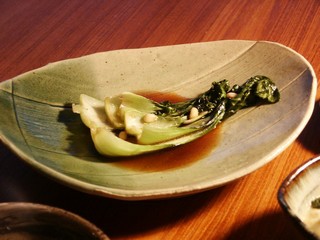I guess I never got around to mentioning that last week I made some godoufu (godofu). It’s been a while since I’ve last done this, but I posted recently on eGullet about it and thought it would be good to revisit it. The pictured godoufu is served after it had only minimally set; it’s in ideal condition after chilling for a few hours. But, alas, hunger won out over flawlessness. I garnished it with some shiso, dressed with some shouyu and konbu-shiitake dashi. There might be a little bit of yuzu zest in there.
This is most of the spread.
A close-up of my not-quite-fully-set godoufu. When fully set and cut, it looks a little more like a bulging block rather than an amorphous blob. It tastes good either way: creamy with a mochi-like texture.
I made misoshiru with daikon and leeks, as well as nasu-no-miso ni. Nasu-no-miso ni is made in many different ways, but it’s basically a braised eggplant dish with miso, usually some mirin, sometimes some sugar. The eggplant is salted and rinsed to remove aku. Sometimes it’s pan-grilled and sometimes it’s deep-fried before simmering with the miso-based sauce. In west Japan it tends to be sweeter; in north Japan it tends to be saltier. Since I was making Arita-style godoufu, I chose to make it a bit sweeter to match the region.
Nasu-no miso-ni is often garnished with sesame seeds (either black or white). It always tastes best on the second day.
A very basic bok choy no itamemono served with a few raw pine nuts. The sauce is shouyu, mirin and my own dashijiru. This takes less than a minute to prepare.
Some simple sunomono with konbu and Japanese-style kyuuri.
This dinner may look moderately complicated, but the only time-consuming part was the godoufu, which takes about 50 minutes, not counting the chilling time to make it set. If, for example, I had my godoufu and tsukemono ready to go, this dinner could be prepared in its entirety in the time it takes to cook rice.
Individual Japanese dishes are rarely terribly complicated, but the time it takes to prepare Japanese food increases with the number of dishes presented. Fortunately, unlike other cuisines, most Japanese foods can be served lukewarm or chilled; other than soup, usually Japanese only serve one or two hot dishes. A number of simmered foods like nimono improve with rest. Ohitashi (blanched, lightly dressed vegetable dishes) are often served cold.
I didn’t take any photos because it was a fried food and I was hungry, but a few days after I made my godoufu, I was trying to think of a way use up the remainder in a different way than I had tried before. So I cut the remaining godoufu and cut it into modestly-sized cubes, and coated with katakuriko. I deep-fried these cubes at about 375F. I served them in a bowl with some Japanese soy sauce, cold Japanese tea and daikon oroshi, much like agedashi-doufu. I was lazy that day and didn’t have any soup stock handy, but I did have some iced Japanese tea on hand, so I improvised. It worked fairly well.
I hate to compare something that most people have likely never tried with something else that most people have never tried, but it reminded me of tamago no tempura. This is one of the few kinds of food which I find a mystery, but basically tamago no tempura is like a poached egg that has been deep fried with a tempura coating. When I had it in a restaurant in Japan, it still seemed to have a relatively soft yolk, and the basic texture was “fuwa-fuwa” (umm… fluffy?) but with a nice crisp coating. My agegoufu was similar except it had a creamier texture.




